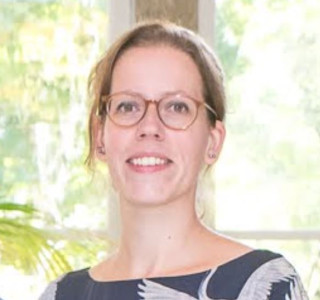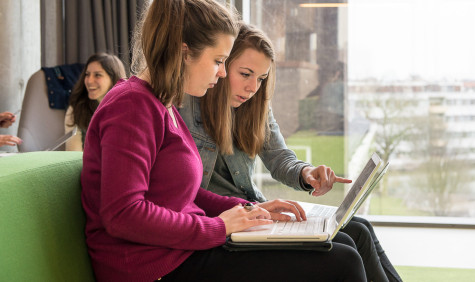Interactive teaching method lets students learn from each other
It is common knowledge that you only really master lesson material when you are able to explain it to another person. How can you make use of that idea in such a way that students also build on each other's knowledge? That question led to the new teaching method: Le-Do-Loop.
In short
Who: Agnes Berendsen
Position: Lecturer
Organisation: Wageningen University & Research (WUR)
Challenge: Online education was mainly focused on sending information, so student engagement was minimal-it was difficult to realise interactivity and depth.
Solution: The Le-Do-Loop method: students work in groups, prepare lessons with interactive work forms (e.g. quiz, puzzle) and teach each other, with the teacher acting as a coach. This increases motivation, insight and interaction.

Agnes Berendsen was a lecturer at Wageningen University & Research during the corona outbreak. From one day to the next, she had to teach her lectures online. "The methods that existed for online teaching were hugely focused on sending information. It was very difficult to engage students in the lesson," she says.
It inspired her and her colleague Cora Busstra to think about alternative, more interactive teaching methods. "We read on SURF's website about Presto, peer assessment in relay form. Students assess each other's work, but only after having to build on that work themselves. Presto involved programming. The idea of continuing to work with someone else's preliminary work is that you are then much more critical of that other person's work. After all, if there is an error in it, it affects you too. As a result, you give each other more focused feedback. The idea of learning from each other in this way appealed to us, but we wanted to add an innovative and important component, namely learning by teaching."
"The methods that existed for online education were hugely focused on sending information. It inspired us to think about alternative, more interactive teaching methods."
Learning and doing
The two wrote a proposal for SURF's open and online education incentive scheme. This was honoured, after which they gathered around them a group of fellow teachers who wanted to implement this concept their education. They titled the project Le-Do-Loop, which stands for Learn-Do-Loop. Berendsen: "The idea is that you divide a class into groups and each group starts working on a subtopic. They have to gain their own knowledge about this subtopic and prepare a lesson about it. We encourage them to use different didactic methods in that lesson: a presentation, but also a quiz, puzzle or other game form. As a teacher, you supervise the groups, are available for questions, check where students get their information from - after all, ChatGPT is not meant to prepare the entire lesson - and make adjustments if you see them going wrong. At the end of the run, groups provide a lesson for their fellow students. In a subsequent run, another group picks up the topic from there and builds on it, so you get to an increasingly higher cognitive level step by step."
Teacher as coach
To test the idea in practice, they used the new teaching method in a new subject for which all materials had yet to be developed. They also applied the concept to small, approximately one-and-a-half-hour practicals. Berendsen also used the Le-Do-Loop for a larger, two-day practical. She explains how the latter went. "Before, students worked through a series of assignments. Now we came up with a series of questions beforehand that students had to be able to explain to each other at the end of the two days. I start the practical with an introduction, briefly refreshing the knowledge and challenging students to activate their knowledge. Then they get to work in groups. My role then changes to that of coach."
"That may seem like an easy role, but it is anything but," says Berendsen. "I experience it as very intensive, because you have to be constantly alert. Instead of determining what I tell, I now have to respond flexibly to students' questions. I have to constantly keep an eye on all groups, to avoid students spending too long at a dead end and wasting their time. Students also make me think. Discussions arise such as: how exactly do you see this? We do it this way now, but can you do it differently? All in all, I find it very inspiring to teach in this way."
"It's a really great way to increase student engagement online and interact with each other online."
High appreciation
The new teaching method has now been in use at WUR for three years. In the first year, that of complete lockdown, reactions were very positive. Not surprising, thinks Berendsen, "Because it is a very nice way to increase student engagement online and interact with each other online."
The second year, the score dropped. What that was due to, the team does not know. But Berendsen dares to speculate. "Presenting online feels a lot safer than in a lecture hall, where you can see the reaction of your fellow students much better. Moreover, everyone experienced the year after corona as tough, both teachers and students. We received a lot of useful feedback from the students. With that feedback, we were able to take concrete action. We now explain even better in advance what the added value of this form of work is. We also benefit from the fact that students are now more familiar with this form of work. They no longer find it strange to have a discussion with a lecturer in the lecture hall. And we as lecturers understand better that we do have to show that we are the experts, by correcting students and asking sharp questions at the right moments. All this leads to another increase in appreciation this year."
Template available
The working form is now a permanent part of WUR's repertoire. Via SURF, the method is also accessible to others. Berendsen: "We have developed a template, a kind of worksheet you can fill in: which topics do students need to learn about? What are your learning objectives? How many loops do you want to apply? In how many groups of what size do you divide a class? What are the feedback moments? That way, you can get started very quickly."
She encourages others to give it a try especially. "I have noticed that you learn a lot as a teacher when you use a new teaching method. Learning a new method is intensive, but it is well worth the investment because you broaden your horizons. The power of Le-Do-Loop is that, as a teacher, you gain much more insight into students' ways of thinking. That can be very enlightening, because unconsciously you yourself are often stuck in a certain thinking pattern. Moreover, you notice very quickly if students do not understand certain things, so you have a better idea of what you need to dwell on. It has helped me enormously to make my lessons attractive and interactive."
More about the Open and Online Education Incentive Scheme
This project was created with help from the Open and Online Education Incentive Scheme. View more results from the scheme's projects.
